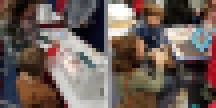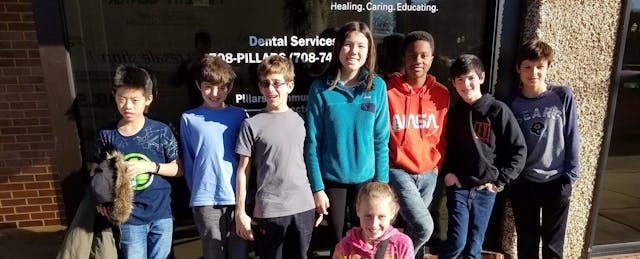We pulled up to a building, which looked like a storefront from the outside. As we entered, anxiety set in—at least for me. The inside had a factory aesthetic, with old furniture strewn about and folding tables arranged in the center of the room. One of our mantras is “anywhere can be a makerspace,” so I started repeating those words in my mind but it didn’t help, I was distressed. Then I looked around the room and realized that my students had a different view. They saw endless possibilities.
“This shelf can be where we keep the bolts of fabric,” one called. “Here are some outlets for the hot glue guns,” another shouted. “Sphero soccer can be in the middle of the room—but how can we build walls so the Spheros don’t go all over the place?” another asked his peers about the game he had designed specifically for the event, complete with a bracket.
Immediately, my students bolted into action and the redesign began. In under an hour, nine students transformed a dilapidated room into a functioning makerspace with stations that would support the children living in Pillars Community Health-Constance Morris House (CMH), a domestic-violence shelter located in the Chicagoland area.
The location had been reserved by CMH for a holiday event, and our goal was to create a pop-up makerspace that children could engage in while their parents shopped for the holiday season. Sewing machines, robotics, circuitry and virtual reality were among the stations designed and operated by our students. The majority of the children they worked with were using these electronics and tools for the first time.
Perhaps the most unique part of this experience? It wasn’t arranged through an academic class or a school club. In fact, the event took place on a Saturday. This project was part of our student-led mobile innovation program and after three months of planning, we were finally ready to set up shop.
Making Space
Located 30 miles north of Chicago, Lake Forest Country Day School (LFCDS) is an independent school that serves students from pre-k through eighth grade. In 2016, we opened a state-of-the-art, 2,800 square foot innovation space to support our STEAM and innovation program. Our vision was to create community both within and beyond the walls of the space.
As the innovation space coordinator at LFCDS, part of my job is to build and nurture that community, and as such, I have the opportunity to work beside students and other teachers regularly.
The innovation space includes a “think tank” room with writable surfaces and flexible furniture designed for ideating, a robotics lab where our upper school Lego robotics program is housed and an innovation lab, which provides work space, tools and resources for projects.
Teachers can bring their classes to visit and use the space to enhance their lessons. This year, a seventh grade English class designed games to highlight the theme in “The Giver” and a second grade class built gingerbread models of Chicago landmarks for an interdisciplinary math and social studies unit.
The innovation space is run as an “open shop,” so in addition to classes visiting, individual students may also drop in and use materials and supplies for self-initiated projects. Lower school students can visit before school and upper school students are welcome during their snack and recess time.
Since opening the space, we’ve seen some remarkable independent projects develop. We’ve seen students build drones, create video games and use CAD software to design items that were more complex than anything they were doing with our curriculum at the time, and the process was even more impressive than the product. We wanted to give our students a platform to discuss their work and to teach others.
Over the past two years, 20 percent of our upper school students have devoted their time on at least one weekend to present at conferences and workshops throughout Chicagoland. We’ve run stations at Maker Faires, demonstrated tools for teachers at professional development conferences and taught CAD Design at student conferences.
All of these events took place, and were planned and prepared for, by students outside of the regular classroom hours.

Presenting at conferences was surprisingly easy to initiate as we’re fortunate to have great organizations in Illinois that support technology teachers. The Illinois Computing Educators (ICE) and our regional subgroup, The Northern Illinois Computing Educators (NICE), both offer a variety of conference and presentation opportunities and have encouraged us to bring student presenters.
Sharing at conferences was working well, but our students wanted more. Empathy, which is a core emphasis at our school, is woven into our innovation space. Our students frequently express their desire to fundraise for a broad range of worthy causes and many of the students who use the space for independent projects are building solutions to help others.
This student-led drive—and the self-initiated projects we were seeing come out of the innovation space—led us to create our mobile innovation program.
Going Mobile
Coincidentally, when we first started the mobile innovation program, the county where LFCDS is located was holding a volunteer fair. I attended with a flier and an explanation of our program and received interest from Girl Scouts of the USA, Boys & Girls Club of America and other local organizations. They were eager for our students to run on-site pop-up programs.
Pillars Community Health-Constance Morris House (CMH) was the first opportunity we pursued. Each student planned and created a station focused on a particular tool or theme to run at the mobile makerspace. As always, our goal was for the entire pop-up program to be led by students, but preparing for Constance Morris House was unique. Given the sensitive nature of the community, there was a social-emotional learning element of our planning phase.
With the assistance of Nancy Watson, our school’s licensed clinical social worker, we arranged for Lauren Pagan, director of outreach at CMH, to visit our school to speak with students prior to the event. Pagan led our students in a workshop in which they learned about domestic violence and, especially, how to respect confidentiality.
Logistics for these mobile events can be complex. We don’t have a special vehicle for the program, so we travel separately and the supplies we bring are restricted to the dimensions of my Ford Fiesta. We’re fortunate to have incredibly supportive families at LFCDS. For the CMH event, the nine students arranged carpools among themselves and traveled more than an hour to and from the facility.
Minutes after our set-up was complete, the children from CMH arrived. As they stepped up to different stations, I watched my students transform into mentors. A natural poise emerged as they were put into authentic leadership roles. Hearing middle schoolers confidently and kindly urging kids to wear gloves, directing them to flip their pillows inside out to hide the stitches and reminding them to plug in devices before they leave was incredible.
Our makerspace was slated to run for two hours, but when the parents returned from shopping and found their children so engaged, they decided to stay and join the activities. What was supposed to be a two-hour event ended up lasting five hours.
For students, hitting the road to bring their ideas to the community has been game-changing. It has given them authentic opportunities to be leaders in places outside the classroom, whether through presenting at conferences, leading workshops or setting up pop-up makerspaces.
Creating a pop-up makerspace at CMH gave our students a chance to support children going through a hard time in their young lives. Moving forward, I hope to partner with more local organizations to find creative ways to innovate for good, so that our mobile innovation program can contribute to the development of empathetic citizens.


